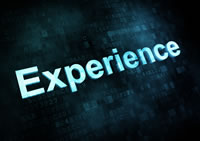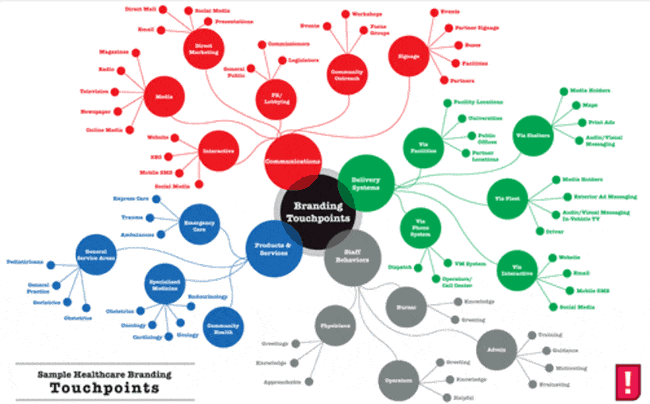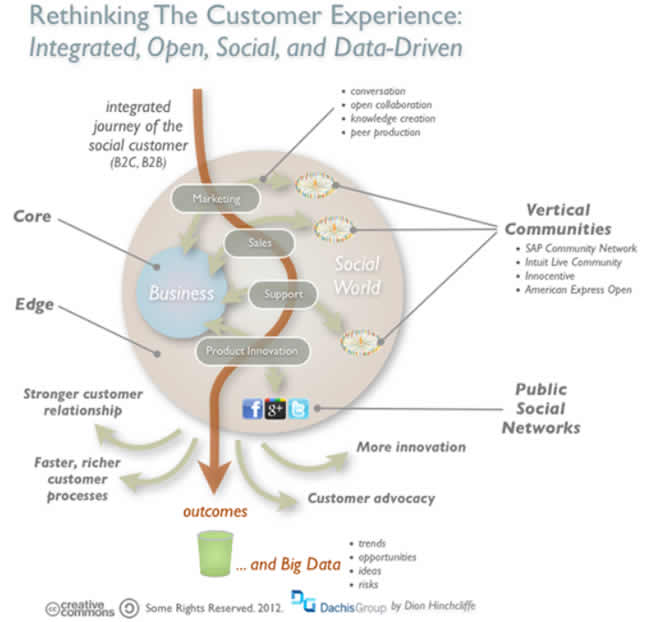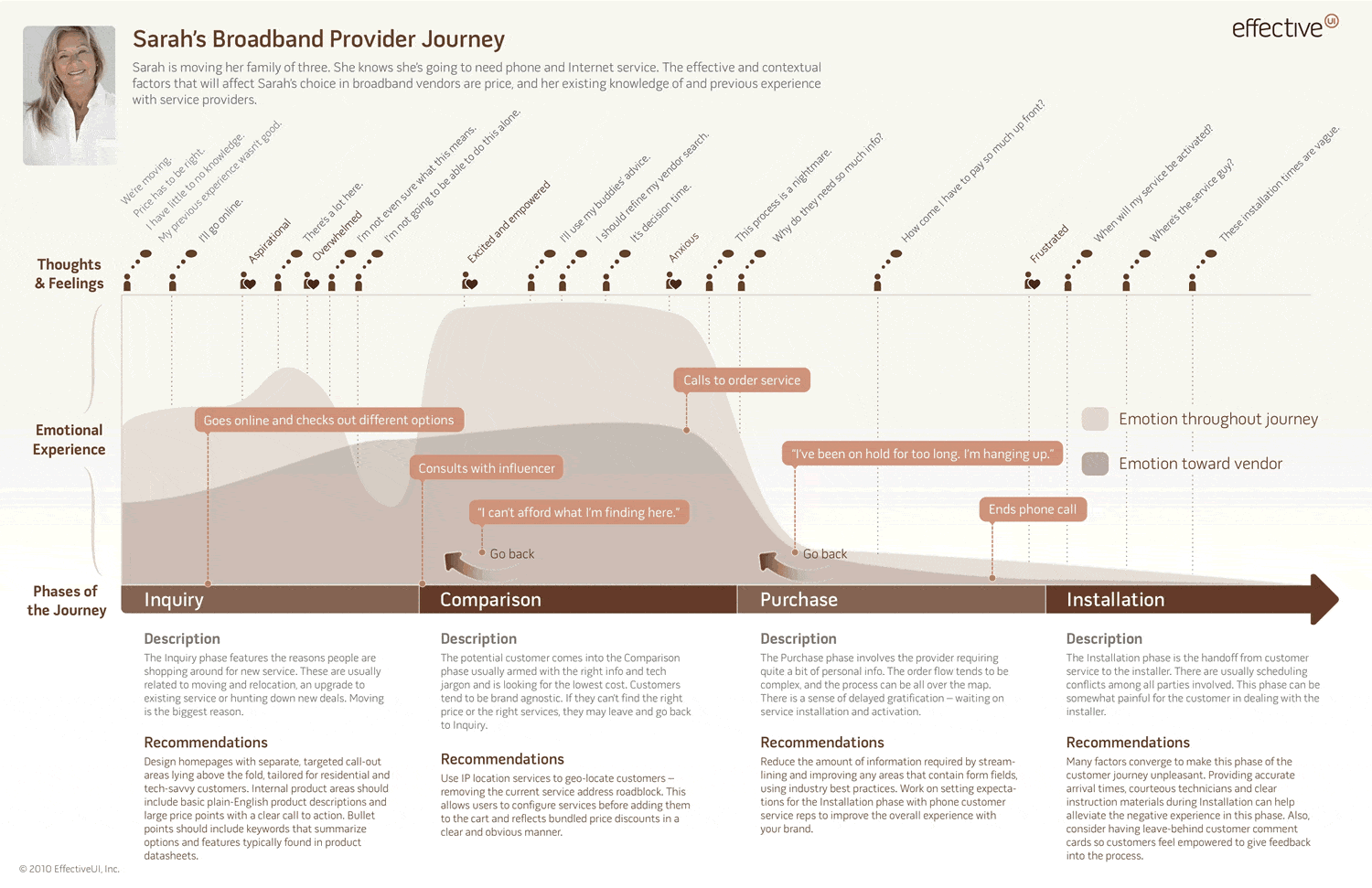Since marketers started looking at the customer life cycle, customer experience management and the customer journey, the attention for that journey has never been higher.
 In its 2009 article on the consumer decision journey McKinsey wrote “Consumers are moving outside the purchasing funnel—changing the way they research and buy your products. If your marketing hasn’t changed in response, it should”. Yet, less has changed than should have. Time to start a series on optimizing the digital and social customer experience from a holistic perspective.
In its 2009 article on the consumer decision journey McKinsey wrote “Consumers are moving outside the purchasing funnel—changing the way they research and buy your products. If your marketing hasn’t changed in response, it should”. Yet, less has changed than should have. Time to start a series on optimizing the digital and social customer experience from a holistic perspective.
A customer-centric and omni-channel view, based upon the customer journey, in correlation with for instance content marketing, touchpoint mapping, customer experience optimization and persuasion/conversion architectures is not new. In B2B marketing we’ ve been using it for quite some time and the customer experience certainly wasn’t a “marketing” area to begin with. But apparently it’s rather new in social media marketing and other marketing techniques. And it also seems rather new in consumer marketing to my surprise.
On the other hand, I suppose that the fact marketers – finally – start to connect the dots, in social as well, maybe the reason why the customer experience – including the journey and touchpoints – can be reasons for this increased attention.
Social media and business has been siloed rather fast and it will be the same with other ‘new ways of doing marketing’. I already see it happening in content marketing (and before on email etc.). Anyway, I’m glad the increased attention is there and not just because we’ve always were obsessed with customer-centricity, customer experiences and the creation of business value through customer value. I’m most of all glad that the increased attention seems to indicate a growing maturity among social media practitioners, digital marketers and people who use content for marketing purposes..
Many changes in the information gathering and buying behavior of people – social, connected – have been happening under our noses since several years now. However, despite all changes, despite the increasing importance of personalized and even personal experiences in a social and connected world, in the end the rules for an optimized digital customer experience haven’t changed – that much and go far beyond personalization, which is just a – sometimes overemphasized – part of the bigger customer experience picture (just as marketing us).
Marketing revolves around customer priorities, preferences, questions, emotions, needs, and how to detect these and turn them into mutual benefits, across all stages of an increasingly dynamic customer journey. How much has it changed in a social world? You will read more about it below but also check the model below from Dion Hinchcliffe’s Forbes post ‘Rethinking the Customer Journey in a Social World‘ below.
Optimizing the customer journey means putting the customer at the center and aligning your goals with the windows of opportunity when customers are ready to be approached, touched and persuaded.
And nowadays it’s often the opposite: they approach, touch and even persuade us. In a sense that’s what inbound marketing and a large part of social media tactics are all about. The customer journey is a connected one and includes peers and trusted advisors. We are not the center of the marketing universe, nor are our businesses or brands. The customer is, as are all touchpoints where we meet them, including the social ones.
This is not a major discovery but it’s an imperative most organizations don’t fully grasp yet as it’s so all-encompassing. And for many it’s a true Copernican revolution, when compared to the one-way approach they heralded for so long. Social has not changed this but it certainly speeded up the must of other models than one-to-many in a reality where many-to-many has become one of the social models of interaction.
The title of this blog post, “optimizing the social and digital customer experience” is a contradictio in terminis. We don’t optimize for media, channels or tactics in the first place. We optimize for the customer so optimizing and the customer experience go hand in hand. When we optimize we think about the customer experience and journey. When we look at marketing from the customer perspective, we can’t but do better and optimize. And, indeed, customer experiences are by definition social and interactive.
When putting the customer and his journey first, the customer experience becomes the focal point of everything we do as marketers. And it’s not just about marketing. It’s about all customer-facing processes and functions, including social CRM and customer service. And it’s also the case in business and management where the customer can, for instance, be the employee.
The customer experience, touchpoints and conversion
The (end-to-end) customer experience is traditionally defined as the sum of all customer experiences a customer has with a business/brand. More about the link between the end-to-end customer experience, individual customer experiences and user experience here.
A touchpoint is something else. W.H. (Hank) Brigman defined a touchpoint as “any influencing action initiated through communication, human contact or physical or sensory interaction.” His definition covers every “touch occasion” a customer can have with the brand, product, or service. Brigman’s examples include less-obvious touchpoints such as walking into a movie theatre and smelling popcorn, hearing pleasant music when shopping in a store, or being able to understand and easily cash in a coupon. You can imagine that with social media the number of touchpoints has largely increased.
The main touchpoint challenges for marketers
- Mapping potential touchpoints as they occur in the context of the customer journey.
- Defining the triggers that open a window of opportunity for persuasion/conversion/engagement.
- Improving the various elements constituting potential touchpoints.
- Having an integrated and channel-agnostic touchpoint approach since the customer experience overlaps media, channels, business functions etc.
- Bringing the social and connected dimension into the equation.
- Moving from a siloed approach to a connected or omnichannel approach, including social, among others in customer service (touchpoints).
Mutually valuable touchpoints are the moments of truth where conversions can occur.
A conversion (e.g. from click to buy) is any action resulting from touchpoints and leading to (desired) outcomes. Integrated and customer-centric touchpoint oriented marketing is not new but it seems that only now it’s being discovered in the ‘social media expert space’. When you want to work with touchpoint mapping or customer experience mapping you can use a tool that’s built to do exactly that. There are several ones on the market. An easy-to-use one I mentioned some time ago is TouchPoint Dashboard. However, you can also use Excel files, mindmaps or the features you find in some marketing software platforms for the enterprise.
When you work with touchpoints it’s important to realize that 1) it requires some thorough thinking and a clear focus on the customer journey and buyers and 2) it’s not always that easy.
To avoid confusion also note that most people talk about interactions and contact moments on the level of channels or real-life contacts (e.g. the branch of a bank). However, others – including me – look at touchpoints as the actual contact itself rather than the channels. To show how touchpoints are looked upon and how complex they can be below is an image showing typical touchpoints – from the channel perspective – in healthcare as I found it on the website of ThinkCreative. I’ll add some Excel files and examples soon myself in the promised follow-up post in this series on optimizing the digital and social customer experience. Note that the model below – you’ll have to click it to fully view it – does not represent a customer journey. It doesn’t look at a buyer persona nor at the journey of an individual customer. It’s a map representing potential touchpoints with a brand – in this case in healthcare. There is a clear difference between customer experience and customer journey mapping on one hand and touchpoint mapping on the other.

Expanding the definition of conversions in a social world
Traditionally we looked at conversions from a sales funnel perspective. However, the stark increase in channels, consumer-controlled interaction possibilities and potential touchpoints, along with the increasing role of all customer-facing processes in marketing (remember customer service) and the social dimension, all require a model that better fits the customer journey reality. The funnel never really existed, that’s why it’s a model (that can still be used, just as the new funnel and customer journey models you see appearing since many years now).
Social media experts, for instance, have defined the concept of engagement, the social customer journey, the dynamic customer journey, you name it. Engagement, they say, is measured by actual outcomes. If we look closely at this, social engagement is nothing more than social conversion. The difference is that we still too often look at conversion from a simple linear perspective: search -> click -> buy. A second difference is that we need to broaden the definition of a customer in an era where you don’t only have to earn the buy.
The customer journey is not linear and conversions are composed of many micro-conversions occurring through various touchpoints, including social ones and indirect ones ABOUT your brand.
Having someone to retweet a message you sent via Twitter, for instance, is a micro-conversion. As these messages travel through the social Web and get retweeted, more micro-conversions happen. However, the value of each conversion differs per touchpoint and scenario. The overall value is defined by the combinations of micro-conversions from a customer journey and lifecycle value (or other marketing) perspective.
More about that social customer journey approach in the graphic below.

Why is the customer experience your imperative?
After this somewhat theoretical introduction, time for the why’s of an optimized customer experience.
Customers don’t want to know how we work
We still too often think in terms of channels, our organization, divisions and silos. Customers notice that and they don’t want to. They want to be treated in the same consistent way no matter where they interact with us. They are channel-agnostic and expect brands to deliver upon their promises online, in-store, on social, on the website, when calling support, etc. Inconsistent and disconnected experiences negatively impact the overall experience and perception. Customers don’t want to know how we work. They want great experiences and will tell others about them.
We are facilitators
The main result of the so-called customer empowerment is the simple fact that people are more informed when they get in touch with us, have more control over how and when they do so and over their time. Each touchpoint should be designed with the customer experience and how customers behave in mind. We don’t say how things should happen, we make sure they can happen as the customers want them to. We facilitate the information gathering and buying journey, rather than sell. And it all starts with the very first impression we make in any touchpoint.
Consistent and continues customer experience optimization works
It’s almost too obvious to write it: improving the customer experience in a consistent and continuous way simply is the path to more revenue, more positive word-of-mouth, a better brand reputation, more loyal customers and higher profit margins, etc. Unfortunately this simple fact and most powerful argument to focus on the customer experience remains undervalued as reports show year after year and regardless of tactics. Note there are two important words here: consistency and continues.
- Consistency is about listening to your customers and making things easy for them, about removing obstacles and any possible doubt about what they are doing at any given point. It’s about integrated flows of improving across different steps in the journey. It’s about not saying ‘Click here to download our folder’ in your call-to-action and next sending people to your homepage. And, finally, it’s about your brand promise and story and how you stick to it.
- Continuity is the must-have step-by-step approach in optimization, regarding conversions and beyond. As conversion marketing expert Bryan Eisenberg says optimization and improvement is not a one-off activity nor is it restricted to any kind of marketing tactics or business processes. Bryan’s concept of ‘continuous improvement’ is one of incremental changes of the customer experience that never ends.
There are thousands of tests and studies, indicating how a more personal approach, a more consistent and human customer experience and continuous optimization improve virtually all marketing parameters, regardless of the medium or tactic.
However, the basic premise is that 1) customers see our business as a whole that is constituted by all touchpoints and 2) that making the interactions and experiences worthwhile is paid back in hard cash. Because frankly, customers really don’t care that much – if at all – about you and your concerns, politics, turf wars, silos or channels. They want to get what they look and pay for and the service they deserve.
How customer-centric are you?
Now, how do you get started? How can you make your digital content, website and other online properties and tactics better and more aligned with your customer’s journey and preferences? Or in other words; how do you become more customer-centric and people-centric which is the real essence of social media marketing and often even social business?
Let’s start with a simple test to gauge how customer-centric and driven by customer experiences you are today. Ask yourself these questions and…answer them.
- Do you spend a budget on optimizing conversion and customer experience that is comparable to the budget you spend on acquisition? (for every 95USD businesses spend on generating traffic, they only spend 1 on conversion optimization).
- Do you spend one fifth of your marketing budget on better serving your existing customers? (existing and satisfied customers are the largest untapped potential of brand advocates).
- What percentage of your existing customers accounts for 80% of your revenue? How many of these people have you ever asked their opinion in person? Do you monitor the social profiles of your top 10% customers?
- Do your employees get a bonus based on customer satisfaction?
- Are you able to identify specific communities of customers or other people in the ecosystem of your business (e.g. bloggers or employees) and what they need from you so you can engage them and they can help you achieve specific business goals?
- Can you describe in a somewhat detailed way what people you had in mind when developing your latest website or blog and do you know what touchpoints they use before buying?
- Can your customer service agent access data about possible complaints customers made on a social network?
- Have you ever developed a marketing strategy or program whereby you actually invited (potential) customers to know what they thought about it, whether it’s by including them in the taskforce or asking them by email or phone?
- Can you name two keywords your – potential – customers use when looking for a product or solution similar to yours in Google?
- Do you think I am able to find what I’m looking for when I visit your homepage in less than 4 clicks?
- Have you ever researched what words your different types of customers use when you writing the content for your website?
- Can you show me the names, profiles, potential social media accounts, transaction history and information preferences of your 3 largest customers in 10 minutes?
- Are you able to adapt the content of your emails depending on non-demographic parameters such as previous interactions, expressed preferences, measured preferences, behavior on other channels, etc. of your subscribers?
- Name at least two channels or tactics you use to listen to your customers or survey them at least once per year.
- Can you tell me one particular action you took based on customer input in the last year?
- Do you use buyer personas and/or customer experience mapping?
In practice, most businesses are unable to answer most of these questions. Start asking them, depending on the social and informational needs of your customers in the broadest sense today. It is all about customer-centricity and the power of community, service and customer experiences.
In a next post I will provide some tips and considerations regarding websites before diving deeper into the social and connected customer experience. To wrap up a special word of thanks to the user experience and customer experience community. Because they have been pioneering in the customer journey and buyer persona field as well as you can see in the 2011 buyer persona customer journey map below (click for larger view) as posted on Smashing Magazine in 2011.
Finally take a look at this blog post, the findings, the graphs and the slideshare in it. The research data and presentation will make you understand better what customer experiences are all about.


